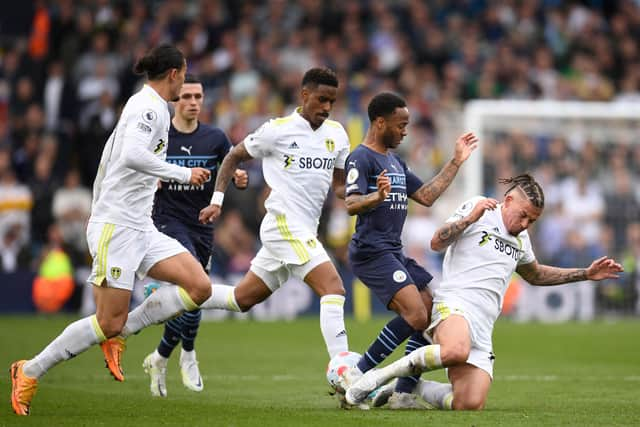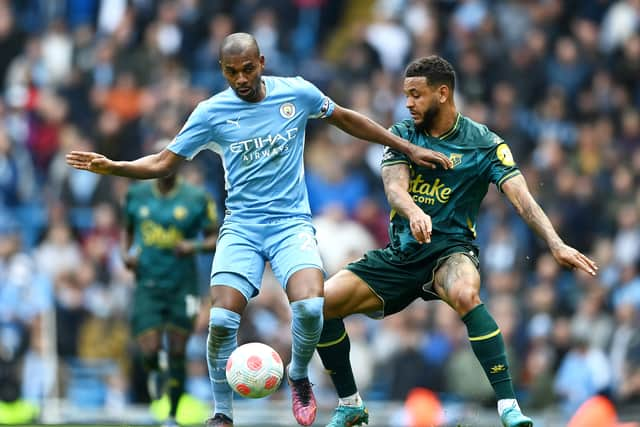What Kalvin Phillips will bring to Man City midfield and how he differs from Fernandinho
and live on Freeview channel 276
It’s only a matter of time until Manchester City secure the signing of Kalvin Phillips from Leeds United.
ManchesterWorld understands a deal is wrapped up for the England international to join the Premier League champions.
Advertisement
Hide AdAdvertisement
Hide AdAs per LeedsLive, the move is being held up with Phillips still away on holiday, although he’s expected to be back by the end of the current working week.
Phillips will come in as a direct replacement for Fernandinho, who departed the Etihad at the end of last season and was unveiled as an Atletico Paranaense player earlier this week.


But the two midfielders are hugely contrasting figures and will provide Pep Guardiola with different options in the centre of the park.
We’ve had a look at their stats on FBref to determine where Phillips and Fernandinho excel, and how drastically their styles differ.
Phillips’s strengths
Advertisement
Hide AdAdvertisement
Hide AdAs per FBref, the 26-year-old impresses when it comes to completing tackles and blocks, particularly in the middle third of the pitch.
But Phillips’s highest numbers come when assessing his ability to press. In fact, the website rank the midfielder among the top 1% of players in Europe’s top-five leagues when it comes to successful pressures.
Phillips applied 28.42 pressures per 90 last term in the Premier League, completing 8.4.


However, where he failed to stand out was in terms of registering goals and assists, and he produced just one of the latter and didn’t manage to find the back of the net once in 2021/22.
Advertisement
Hide AdAdvertisement
Hide AdHowever, Phillips’s role under Marcelo Bielsa should be factored in, and he was asked to play a taxing position in the all-action system. Under the Argentinian, there were fewer passes completed compared to most other sides, while the central midfielder was often overrun in the middle and asked to cover a huge area of the pitch, which will have affected his statistics.
Fernandinho’s strengths
Like Phillips, Fernandinho’s numbers must be viewed in conjunction with how City operate, with Guardiola’s men tending to dominate possession.
Therefore, it’s unsurprising the Brazilian ranked highly for passes attempted and completed, as well as touches on the ball.
But it is, perhaps, unexpected that Fernandinho’s standout figures last season came in forward passes, passes into the box, through balls and dribbles, highlighting his ability on the ball was taken slightly for granted.
Advertisement
Hide AdAdvertisement
Hide AdConversely, the former Shakhtar Donetsk man’s worst numbers came in pressures and blocks, where Phillips excelled.


How do they differ?
The biggest difference between the pair is their ability off the ball, and Phillips will primarily add energy and a greater ability to press the opposition through the centre.
At 37, it’s no surprise Fernandinho couldn’t match the Leeds man’s on-field exuberance last term, and he seemed to be struggling with the pace of elite-level football in the final weeks of the season.
In fact, Guardiola rarely started Fernandinho in midfield for high-stakes matches, with a defensive injury crisis the only reason he was selected at centre-back so often towards the end of 2021/22.
Advertisement
Hide AdAdvertisement
Hide AdPhillips should provide a much more steady and reliable option - he played over 50% more Premier League minutes last season despite missing long periods of the campaign through injury.
Phillips should also offer more tackles and blocks, but will need to be tidier in possession than during his time at Elland Road.
Fernandinho’s passing percentage was at 90.6 last term, compared to Phillips’s 81.5, while his dribble success of 61.5 is well below Fernandinho’s at 88.9%.
For the incoming City recruit, he’ll need to adapt quickly from the chaotic midfield at Leeds, even if it did change slightly under Jesse Marsch, to the control and calm that Guardiola’s men exude in the middle.
Advertisement
Hide AdAdvertisement
Hide AdThere are also the unquantifiable qualities Fernandinho boasted: knowing how and when to foul, his leadership and experience, as well the understanding he had with Guardiola.
But for the Catalan, the arrival of Phillips does offer him the opportunity to play with two high-energy holders or to push the new signing further up and provide more pressing in the middle.
Guardiola also possesses a player who can now play in a similar role to Rodri, should the 26-year-old be absent for any period of time, something he lacked in ‘21/22.
Overall, the champions can justifiably believed they’ve upgraded their resources in that area, even if Phillips does not present the final and complete package for a City-style midfielder.
Comment Guidelines
National World encourages reader discussion on our stories. User feedback, insights and back-and-forth exchanges add a rich layer of context to reporting. Please review our Community Guidelines before commenting.
